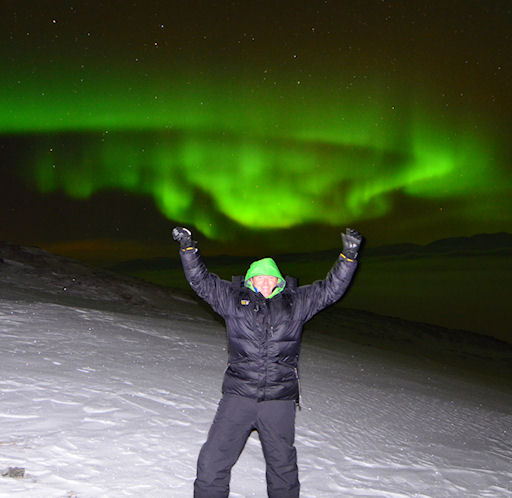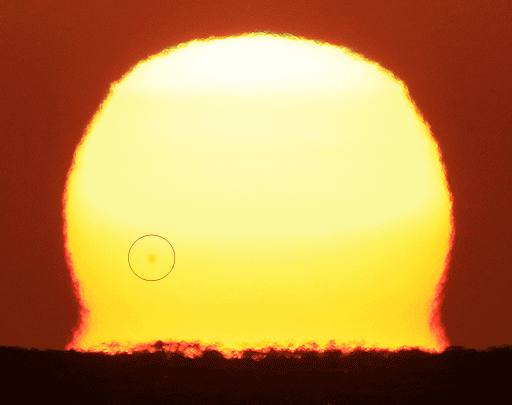IN CASE YOU MISSED IT, THE EPIC BLAST: On Dec. 6th, a magnetic filament stretching more than 700,000 km around the sun's southeastern limb erupted, producing a blast of epic proportions. Earth was not in the line of fire. Click to view a must-see movie from NASA's Solar Dynamics Observatory.
NORTHERN LIGHTS: Last night (Dec. 7th) a minor gust of solar wind gently buffeted Earth's magnetic field. At the Aurora Sky Station in Sweden, above the Arctic Circle, a gentle gust is all it takes to ignite auroras you can reach out and touch ... almost:

"Every night our staff checks spaceweather.com to see what the future may hold," says Sky Station photographer Chad Blakley. "Needless to say, we were all excited when we saw the density of the solar wind rise above 15 protons/cm3. Soon the auroras began, and they did not stop until we all went home six hours later." (For the record, the auroras pictured above were more than 100 km above Blakeley's head.)
A more forceful gust of solar wind is en route to Earth, due to arrive on Dec. 10th. High-latitude sky watchers should remain alert for auroras.
more images: from Marketa Stanczykova of Iceland, Reykjavik; from Borkur Hrolfsson of Þingvellir, Iceland; from Frank Olsen outside Tromsø, Norway; from Fredrik Broms of Kvaløya, Norway; from Börkur Hrólfsson of Reykjavik, Iceland; from Øystein Lunde Ingvaldsen of Bø in Vesterålen, Norway; from Kjetil Skogli outside Tromsø, Norway;
SUNSPOT SUNRISE: Sunspot 1131 is so big, it can be seen without the aid of a solar telescope. On Dec. 6th, Terry Reis "spotted" it while photographing the sunrise from White Plains Beach, Oahu, Hawaii:

Photo details: Canon 5D, Canon 600mm w/.025 extender, ISO 400, F8, 1/8000s
"Other than the sunspot, it was a completely routine Hawaiian sunrise," says Reis. "Beautiful!"
Sunspot 1131 is big, but quiet. The behemoth spot has a simple, stable magnetic field that poses little threat for a major eruption. At the moment it is producing more pretty pictures than solar flares. Browse the links, below, for examples.
more images: from Rogerio Marcon of Campinas SP Brasil; from John C McConnell of Maghaberry, Northern Ireland; from Theo Ramakers of Social Circle GA; from Monika Landy-Gyebnar of Veszprem, Hungary
WARNING: Even when the sun is dimmed by fog or low-hanging clouds, it can still damage your eyes. Do not stare directly at the sun or look at the sun through unfiltered optics. If you attempt to photograph a dim sun, do not look through the optical viewfinder. Instead, compose the scene using the camera's digital viewscreen.
November 2010 Aurora Gallery
[previous Novembers: 2009, 2008, 2007, 2006, 2004, 2003, 2002, 2001, 2000]
Potentially Hazardous Asteroids (
PHAs) are space rocks larger than approximately 100m that can come closer to Earth than 0.05 AU. None of the known PHAs is on a collision course with our planet, although astronomers are finding
new ones all the time.
On December 8, 2010 there were 1167 potentially hazardous asteroids.
Notes: LD means "Lunar Distance." 1 LD = 384,401 km, the distance between Earth and the Moon. 1 LD also equals 0.00256 AU. MAG is the visual magnitude of the asteroid on the date of closest approach. | | The official U.S. government space weather bureau |
| | The first place to look for information about sundogs, pillars, rainbows and related phenomena. |
| | Researchers call it a "Hubble for the sun." SDO is the most advanced solar observatory ever. |
| | 3D views of the sun from NASA's Solar and Terrestrial Relations Observatory |
| | Realtime and archival images of the Sun from SOHO. |
| | from the NOAA Space Environment Center |
| | the underlying science of space weather |

